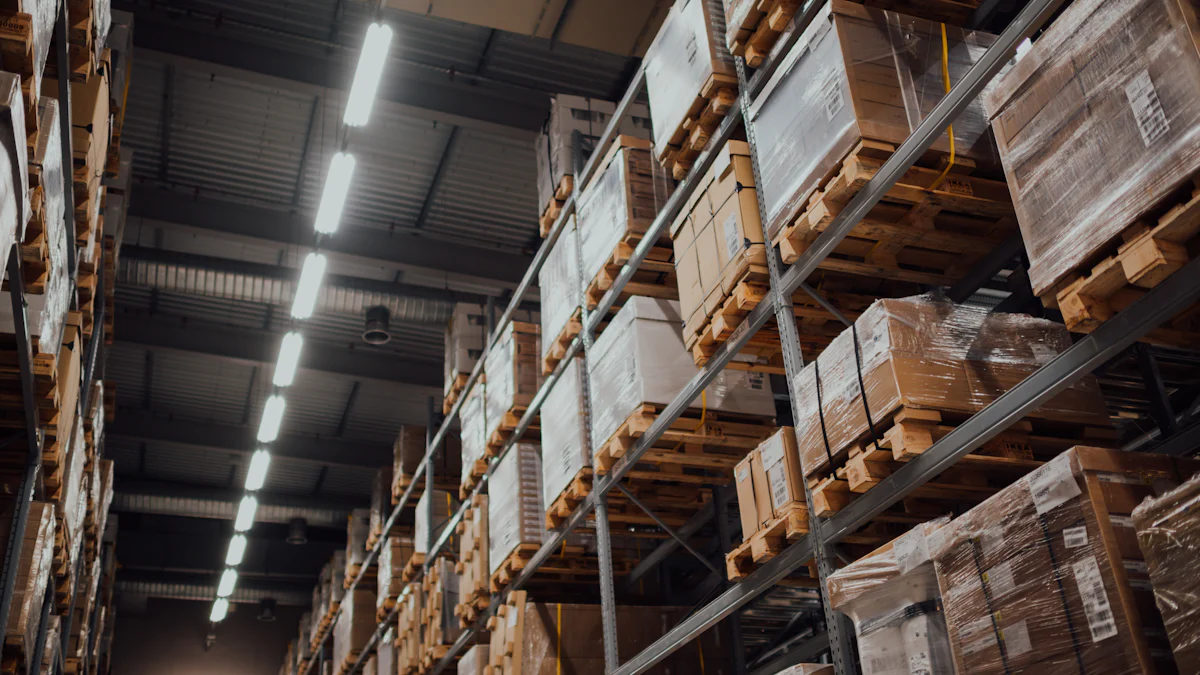Why Logistics Integration is Essential for Business Success

Logistics integration plays a pivotal role in the seamless coordination of various business operations. In today's competitive landscape, the significance of efficient logistics integration cannot be overstated. This blog aims to shed light on how businesses can leverage integrated logistics to optimize processes and drive success. By understanding the core concepts and benefits of logistics integration, companies can enhance their operational efficiency, reduce costs, and ultimately improve customer satisfaction.
Understanding Logistics Integration
Logistics integration involves the seamless coordination of various aspects within a business's operations. It plays a crucial role in optimizing processes and driving success. Understanding the core concepts and benefits of logistics integration is key for companies to enhance their operational efficiency, reduce costs, and improve customer satisfaction.
What is Logistics Integration?
Definition and Key Components
The concept of logistics integration encompasses the harmonious unification of different functions within a company's supply chain. By integrating processes such as inventory management, transportation, and warehousing, businesses can achieve a more streamlined and efficient operation.
Historical Context and Evolution
Throughout history, pivotal events like the Industrial Revolution have transformed transport systems, enabling faster and more efficient flow of goods. In the digital era, radical changes in logistics have occurred with the advancement of digital technology and the information age. These advancements have significantly influenced the evolution of logistics integration practices.
Types of Logistics Integration
Internal vs. External Integration
Internal logistics integration focuses on aligning various departments within an organization to work cohesively towards common goals. On the other hand, external integration involves collaborating with external partners such as suppliers and distributors to create a seamless supply chain network.
Horizontal vs. Vertical Integration
Horizontal logistics integration refers to the collaboration between entities at the same level of the supply chain hierarchy. In contrast, vertical integration involves partnerships between entities at different levels of the supply chain to enhance overall efficiency and coordination.
Benefits of Logistics Integration

Operational Efficiency
Logistics integration revolutionizes the way businesses operate, leading to streamlined processes that enhance overall efficiency. By optimizing the flow of goods and information, companies can achieve unprecedented levels of operational excellence.
Reduced operational costs
One of the key advantages of logistics integration is the significant reduction in operational costs. Through efficient coordination and resource utilization, businesses can minimize expenses while maximizing output, ultimately boosting profitability.
Enhanced Customer Satisfaction
With logistics integration in place, businesses can offer faster delivery times to their customers. The seamless coordination of supply chain activities ensures timely order fulfillment, leading to increased customer satisfaction and loyalty.
Improved order accuracy
Logistics integration plays a crucial role in improving order accuracy. By streamlining processes and enhancing visibility across the supply chain, companies can ensure that orders are fulfilled accurately and promptly, resulting in enhanced customer trust and repeat business.
Competitive Advantage
Better market responsiveness
By integrating logistics functions, businesses can respond more effectively to market demands and changes. The agility gained through streamlined operations allows companies to adapt quickly to shifting trends, gaining a competitive edge in the industry.
Increased flexibility and scalability
Logistics integration provides businesses with increased flexibility and scalability. Companies can adjust their operations according to demand fluctuations, expand into new markets seamlessly, and grow their business sustainably over time.
Supply Chain Visibility
Real-time tracking
Logistics integration provides businesses with real-time tracking capabilities throughout the supply chain. By leveraging advanced technologies and integrated systems, companies can monitor the movement of goods at every stage, ensuring transparency and efficiency in operations.
Improved decision-making
With enhanced logistics integration, companies can make informed decisions based on real-time data and insights. The visibility gained through integrated systems allows for proactive problem-solving, strategic planning, and agile responses to changing market conditions.
Waste Reduction
Efficient resource utilization
Through logistics integration, businesses can optimize their resource allocation and utilization. By streamlining processes and improving coordination across departments, companies can minimize waste, reduce excess inventory, and maximize the efficiency of their operations.
Space-saving in warehousing
Integrated logistics plays a crucial role in space-saving within warehousing facilities. By implementing efficient routing strategies and inventory management practices, businesses can utilize warehouse space more effectively, reducing storage costs and enhancing overall operational productivity.
Implementing Logistics Integration
Steps to Successful Integration
Assessing current logistics processes
To ensure a seamless transition towards integrated logistics, companies must first evaluate their existing logistical procedures. By analyzing the efficiency and effectiveness of current operations, businesses can identify areas for improvement and optimization.
Identifying integration opportunities
Once the assessment is complete, organizations should actively seek out opportunities for integration within their supply chain. This involves pinpointing specific touchpoints where different functions can be harmoniously merged to enhance overall operational performance.
Tools and Technologies
Software solutions
The implementation of advanced logistics integration software is paramount in streamlining operations and achieving real-time visibility across the supply chain. These solutions offer end-to-end tracking capabilities, inventory management functionalities, and data analytics tools to drive informed decision-making.
Automation and AI
Embracing automation technologies and artificial intelligence (AI) systems can significantly enhance the efficiency of logistics integration processes. By automating repetitive tasks, optimizing route planning, and leveraging AI algorithms for predictive analysis, businesses can unlock new levels of productivity and agility.
Challenges and Solutions
Common obstacles
While implementing logistics integration, companies may encounter challenges such as resistance to change, legacy system compatibility issues, or lack of internal alignment. Overcoming these hurdles requires proactive communication, stakeholder engagement, and a clear roadmap for implementation.
Strategies to overcome challenges
To address these challenges effectively, organizations should focus on fostering a culture of innovation and continuous improvement. By providing adequate training, incentivizing adoption of new technologies, and establishing cross-functional collaboration frameworks, businesses can navigate obstacles successfully on their journey towards integrated logistics excellence.
Case Studies

Successful Examples of Logistics Integration
Company A: Streamlining supply chain
Company A successfully implemented logistics integration to streamline its supply chain operations. By harmonizing various functions such as inventory management, transportation, and order fulfillment, the company achieved a significant reduction in lead times and operational costs. The seamless coordination facilitated by logistics integration allowed Company A to optimize its processes, enhance efficiency, and improve overall customer satisfaction.
Company B: Enhancing customer experience
Company B exemplifies how logistics integration can enhance customer experience. By integrating supply chain activities with a focus on customer-centric strategies, Company B improved order accuracy, reduced delivery times, and enhanced product availability. This approach not only increased customer satisfaction but also fostered loyalty and repeat business. The successful implementation of logistics integration at Company B showcases the transformative impact it can have on enhancing the overall customer experience.
Lessons Learned
Key takeaways
The key takeaway from these case studies is the pivotal role that logistics integration plays in driving operational excellence and enhancing customer satisfaction. Companies that prioritize integrated logistics benefit from streamlined processes, reduced costs, improved visibility, and increased agility. By learning from the success of companies like Company A and Company B, businesses can glean valuable insights into implementing effective logistics integration strategies tailored to their unique needs.
Best practices
Embracing advanced technologies and software solutions is essential for successful logistics integration. Companies should invest in platforms that offer real-time tracking capabilities, data analytics tools, and automation features to optimize their supply chain operations. Additionally, fostering a culture of collaboration, innovation, and continuous improvement across departments is crucial for overcoming challenges and maximizing the benefits of integrated logistics. By following these best practices, businesses can unlock the full potential of logistics integration to drive success in today's dynamic business landscape.
Embracing logistics integration is paramount for businesses striving for success.
Unlock benefits like reduced costs, enhanced efficiency, and improved customer satisfaction.
The future of business prosperity lies in seamless logistics integration.
Take action today to integrate your logistics functions and thrive in the competitive market.
See Also
The Importance of Security in Supply Chain Logistics
Achieving Manufacturing Success with Lean Logistics
Innovative Supply Chain Impact on Logistics Revolution
